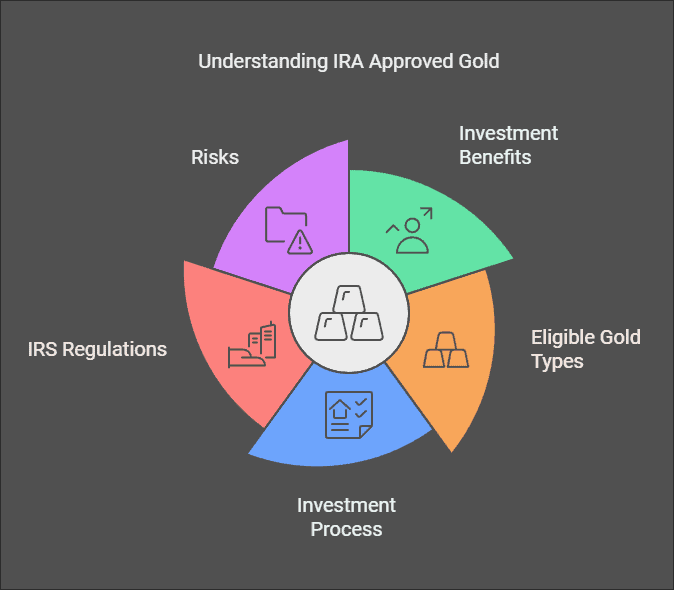Investing in IRA Approved Gold offers a unique investment opportunity to diversify retirement savings with physical gold, a valuable commodity among precious metals. An Individual Retirement Account (IRA) is a tax-advantaged retirement account designed to help individuals optimize their retirement funds, with IRA Approved Gold meeting specific IRS regulations for inclusion.
This includes American Gold Eagles, Canadian Gold Maple Leafs, and gold bars with a minimum purity of 99.5%. These IRA-eligible gold investments serve as a hedge against inflation and financial uncertainty, offering benefits such as portfolio diversification and tax advantages.
To invest in IRA Approved Gold, a form of physical metals, follow essential steps:
- Select a reputable IRS-approved custodian.
- Open a self-directed IRA.
- Fund the account.
- Purchase IRS-compliant gold coins and gold bars.
- Store it in an approved depository.
Adhering to IRS regulations is crucial to protect retirement assets and ensure compliance with contribution limits and storage requirements.
While investing in gold offers advantages, it also involves risks such as market fluctuations, counterparty risk, and potential scams. Understanding these factors, along with higher fees and economic uncertainty, will help maximize benefits and safeguard your investment.
Key Takeaways:
- IRA Approved Gold is a type of investment that is allowed in Individual Retirement Accounts (IRAs), providing a way to diversify and protect retirement savings.
- To invest in IRA Approved Gold, you must have a self-directed IRA account and purchase eligible gold through an IRS-approved custodian. There are rules and regulations governing the amount and tax implications of IRA Approved Gold investments, including annual contributions and tax-deferred growth.
- While IRA Approved Gold can provide benefits such as hedging against inflation and portfolio diversification, there are also risks involved such as market fluctuations, counterparty risk, and potential fraud. It is important to carefully consider these risks and consult a financial advisor before investing.
What is an IRA?
An Individual Retirement Account (IRA) is a savings account with tax advantages designed for retirement savings.
IRAs include types such as traditional IRAs, Roth IRAs, and SEP IRAs, each offering unique benefits, contribution limits, and tax advantages.
IRAs help individuals optimize retirement savings while providing potential tax benefits.
What is IRA Approved Gold?
IRA Approved Gold is physical gold that meets IRS criteria for inclusion in Individual Retirement Accounts, including specific coins and bars.
Eligible forms of IRA-approved gold include:
- American Gold Eagles
- Canadian Gold Maple Leafs
- Gold bars with a purity of 99.5% or higher
IRA Approved Gold serves as a hedge against inflation and financial uncertainty.
What Types of Gold are Eligible for IRA Investment?
Eligible types of gold for IRA investment include:
- American Gold Eagles
- Canadian Gold Maple Leafs
- Gold bars with a minimum purity of 99.5%
Gold must be produced by approved mints and meet IRS standards to qualify for IRA inclusion, ensuring compliance with IRS regulations and storage requirements.
What are the Benefits of Investing in IRA Approved Gold?
Investing in IRA Approved Gold, a form of gold-related investments, offers benefits like inflation protection, portfolio diversification, and tax advantages.
Gold acts as a hedge against inflation, its value typically rising during economic uncertainty.
Including gold in a retirement portfolio diversifies assets and mitigates stock market risks.
Tax-deferred growth in IRAs allows gold investments to compound over time.
How to Invest in IRA Approved Gold?
To invest in IRA-approved gold, follow these steps:
- Select an IRA-approved custodian.
- Open a self-directed IRA account.
- Fund the IRA account.
- Purchase IRS-approved gold from a reputable dealer.
- Store the gold in an IRS-approved depository.
Investing in IRA-approved gold ensures compliance with IRS regulations while adding physical gold, a key component of precious metals IRAs, to your retirement portfolio.
Step 1: Choose a Custodian
- Choose a CustodianChoose a reputable IRA-approved custodian to manage your self-directed IRA and ensure compliance with IRS regulations and storage requirements.
When evaluating custodians, consider their fee structure; transparent fees help you understand the total investment cost.
Research the custodian’s reputation through reviews and ratings to gauge reliability and client satisfaction, and ensure they are among trusted gold companies.
Ensure the custodian has expertise in precious metals to provide valuable insights and tailored services.
The custodian ensures compliance with IRS regulations and facilitates seamless gold transactions.
Step 2: Open a Self-Directed IRA Account
To open a Self-Directed IRA account, first select a custodian specializing in self-directed IRAs, which allow for alternative investments like gold IRAs.
Complete the application process, including providing personal identification and funding the account.
Next, choose and purchase alternative investments like real estate or private equity through the custodian.
Step 3: Fund Your IRA Account
Fund your IRA account by contributing funds, adhering to IRS annual limits for retirement accounts.
Funding methods include rollovers from previous employer plans and direct transfers between traditional IRAs or Roth IRAs.
New contributions can be made annually to benefit from tax-deferred growth.
Be aware of contribution limits to avoid penalties.
Step 4: Purchase IRA Approved Gold
Purchase IRA Approved Gold by selecting IRS-compliant gold coins or bars through your custodian.
To ensure IRS compliance, choose gold products like American Gold Eagles from reputable dealers and process the purchase with your custodian, considering your investment profile and financial goals.
Maintain thorough transaction records for accurate reporting and compliance.
What are the Rules and Regulations for Investing in IRA Approved Gold?
Investing in IRA Approved Gold requires adherence to IRS rules, including purchasing gold with a purity of at least 99.5%, storing the gold in an approved depository, and ensuring transactions are handled through a custodian.
Gold must be in the form of bullion coins or bars to qualify.
Compliance with these regulations protects retirement assets and maintains the integrity of the retirement account.
What is the Maximum Amount of IRA Approved Gold You Can Hold in Your Account?
The maximum amount of IRA-approved gold you can hold depends on IRS contribution limits and the total value of your retirement account, highlighting the importance of annual contributions.
IRS regulations limit annual contributions to IRAs, affecting how much gold can be included.
Gold holdings in IRAs must comply with IRS rules regarding contribution limits and account value.
What are the Tax Implications of Investing in IRA Approved Gold?
Investing in IRA approved gold impacts taxes by allowing tax-deferred growth and potential tax-free withdrawals, based on the IRA type.
Traditional IRAs may offer tax deductions on contributions, while Roth IRAs provide tax-free withdrawals in retirement.
Understanding these tax implications helps maximize retirement investment benefits and align with your wealth protection kit.
What are the Risks of Investing in IRA Approved Gold?
The risks of investing in IRA Approved Gold include market fluctuations, counterparty risk, liquidity risk, and potential fraud.
- Market fluctuations affect the value of gold, causing potential losses.
- Counterparty risk occurs if the dealer defaults or fails to deliver the gold.
- Liquidity risk arises if selling gold quickly is difficult.
- Potential fraud and scams can lead to financial loss.
Market Fluctuations
Market fluctuations affect the value of IRA-approved gold, influencing potential investment gains or losses.
Gold prices typically rise during economic uncertainty or high inflation, serving as a safe haven.
Geopolitical tensions, monetary policy changes, and supply-demand shifts impact these fluctuations.
A strong U.S. dollar can decrease gold prices, affecting IRA gold investment value and overall market fluctuations compared to indices like the S&P 500.
Counterparty Risk
Counterparty risk is the potential for financial loss if a trusted party, like a gold company or custodian, fails to meet their obligations for your IRA Approved Gold investment, affecting your trading and investment strategy.
Failures can include mishandling assets or bankruptcy, affecting the delivery of purchased gold.
To mitigate counterparty risk, select reputable custodians with a strong track record to secure your investment.
Liquidity Risk
Liquidity risk refers to the difficulty of selling assets quickly without impacting their price.
Liquidity risk increases during market volatility when converting assets like gold into cash can become challenging.
Understanding liquidity risk helps investors manage their investments effectively, particularly when balancing gold investments with other commodities and ETFs.
Fraud and Scams
Fraud and scams in IRA Approved Gold investments involve misrepresentation of gold value or legitimacy by untrustworthy entities.
Common schemes include selling overpriced or counterfeit gold and using high-pressure sales tactics.
To avoid fraud, verify the credentials of gold companies through reviews and ensure adherence to IRS regulations and proper documentation.
Frequently Asked Questions
What is IRA approved gold?
IRA approved gold refers to physical gold coins or bars that meet certain criteria set by the Internal Revenue Service (IRS) and can be held within an Individual Retirement Account (IRA).
What are the requirements for gold to be considered IRA approved?
The gold must have a fineness of at least 0.995, be produced by an approved mint, and be held by a qualified trustee or custodian in a IRS-approved depository.
What are the benefits of holding IRA approved gold?
Holding IRA approved gold, including gold coins and gold bars, can diversify your retirement portfolio, protect against inflation, and provide a hedge against market volatility. Precious metals like gold are an excellent investment opportunity during periods of economic uncertainty and financial uncertainty.
Are there any restrictions on purchasing IRA approved gold for your individual retirement account?
Yes, there are restrictions on the types of gold that can be purchased for an IRA. For example, collectible coins or certain types of bullion, such as non-IRA-eligible gold, may not be eligible. It is crucial to adhere to IRS regulations when making these investments.
How is IRA approved gold and other precious metals IRAs valued?
The value of IRA approved gold is based on the current market price of gold and gold-related investments. This includes physical metals, gold bullion, and other commodities. It is important to regularly monitor the value of your gold holdings and make adjustments as needed to maintain a balanced portfolio, especially during market fluctuations and economic recovery periods.
Can I take physical possession of my IRA approved gold and other physical gold?
No, you are not allowed to physically possess the gold held within your IRA, whether it’s a traditional IRA, Roth IRA, or self-directed IRA. It must remain in the custody of the qualified IRA trustee or IRS-approved custodian in an IRS-approved depository until you reach retirement age and are eligible to make withdrawals, in accordance with IRS regulations.
Authors & Disclosures
- Our content is independently written and reviewed by trusted reviewers & fact-checkers.
- We can earn money by connecting you with top Gold IRA Companies. Learn how our reviews work.
- Want to learn more? Meet our authors and explore our editorial policy.














